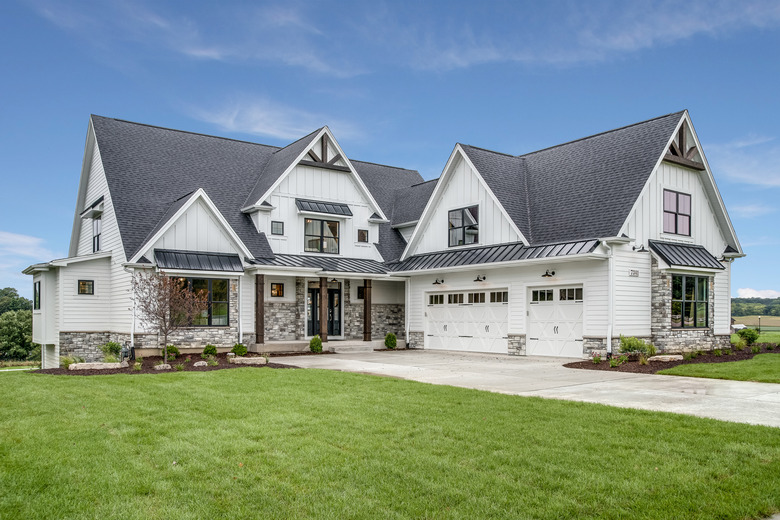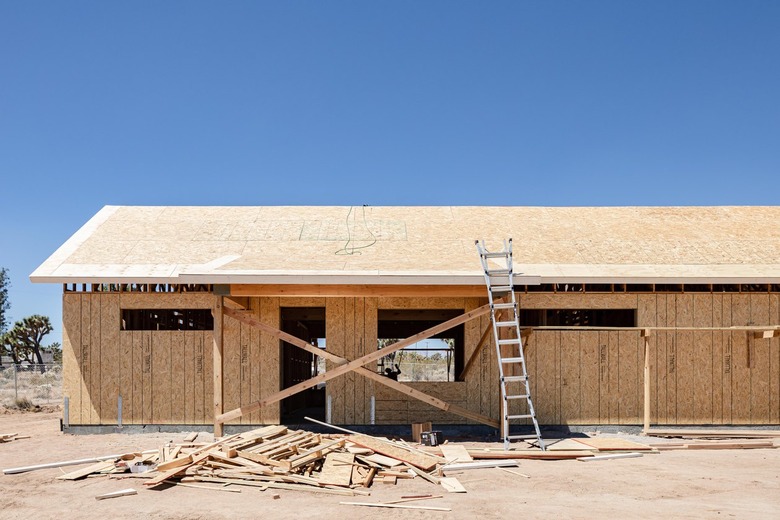Asphalt Shingles: A Cost And Buyer's Guide
We may receive a commission on purchases made from links.
Many people believe that the only reason asphalt shingles are so popular is because they are less expensive than other types of roofing. While it's true that on average it costs more to have other products installed, such as wood shakes or standing seam metal roofs, asphalt shingles have other qualities that have helped them grab about 70 percent of the residential roofing market.
For one, the term "asphalt shingles" encompasses a wide range of products that include everything from builder-grade shingles to thick, textured luxury products that create pronounced shadow lines on the roof. Many are made to look like more high-end slate shingles or wood shakes. They come in a variety of different colors, making it easy to coordinate with siding and trim colors.
Asphalt shingles are reasonably long-lived. You can get a good 20 to 30 years — or more with premium asphalt shingles — from an asphalt roof. They are easy to install, so unless the labor market is very tight in your area, you should not have a problem finding a competent roofing contractor. In fact, just about all roofers can install asphalt shingles, but not every roofer has the skill set to handle other types of roofing, such as slate or metal.
What Are Asphalt Shingles?
What Are Asphalt Shingles?
There are two types of asphalt shingles on the roofs of houses in the United States: organic and inorganic, also known as fiberglass shingles. Organic shingles have a reinforcing mat made of materials like cardboard or cellulose. The mat gets a coating of asphalt to make the shingle waterproof. An application of mineral granules protects the asphalt and provides color to the shingles.
Inorganic shingles are much the same except the reinforcing mat is made of fiberglass. Many people refer to them as fiberglass shingles. Fiberglass asphalt shingles have a number of benefits. They are lighter than organic shingles, and they are less prone to curling and cracking due to temperature changes.
Fiberglass shingles have a Class A fire rating. That means they are better able to resist fires and the spread of fires than most organic shingles, which have a Class B or C rating.
While there are still many homes with organic asphalt shingles, all new shingles sold today are fiberglass asphalt shingles. All of the major roofing product manufacturers stopped producing organic shingles around 2008, but there are many roofs with organic shingles still in use.
What Do Asphalt Shingles Cost?
What Do Asphalt Shingles Cost?
Because asphalt shingles are available in a wide range of styles and colors, there is a wide range of costs that depend on the quality of the shingles among other things. The estimate you get from a roofing contractor will include the shingles, the labor — which is about 60 percent of the cost of a new roof — and the other components that go into installing a roof.
Roofing manufacturers offer a number of product lines. They may use different naming conventions, but most products fall into one of three general categories:
- Three-tab shingles: Each of these shingles has three cutouts, or tabs, on the lower half of the shingle, which is left exposed after installation. These shingles provide a flat appearance, although they are offered in a number of colors. This is considered the basic shingle. A roofing project including installation would cost about $350 to $450 per square, which is roofing lingo for 100 square feet.
- Architectural shingles: These shingles, also called dimensional or laminated shingles, are the next step up and are the most widely used type of asphalt shingle, especially for re-roofing projects. If you discuss a re-roofing project with a roofer, the discussion will probably start with architectural shingles. They are thicker and have more texture than three-tab products. Expect to pay about $450 to $550 per square installed.
- Premium shingle: Also called luxury shingles, these products are the thickest and most textured shingle a manufacturer will offer. They are often designed to look like more expensive, high-end products, such as slate or wood shakes. A premium shingle installation will cost about $550 to $850 per square.
Other factors that will affect the cost of a re-roofing job include tearing off and carting away the existing roofing material. You can expect to pay about $1 to $3 per square for this work.
Very steep roofs cost more than less steep roofs. The steepness of a roof is called the roof pitch, and it is a ratio of inches of vertical rise over 12 inches of horizontal run. A roof that rises 4 inches per every 12 inches of run is called a 4 in 12 or 4:12 roof. Once the pitch gets up to about 9:12 and above, roofers need additional safety equipment to work, and installation becomes more difficult.
Making repairs to the roof deck during re-roofing will increase the final cost by $2 to $4 per square foot of repair area. The problem is the roofer won't know what needs to be repaired or replaced until the old roof is removed. So, repair costs are added to the estimate at the end of the job. The roofing contract will list the square footage price to replace roof decking, or it will list a cost for each 4 x 8 sheet of plywood used to replace damaged roof decking.
Specialty Asphalt Shingles
Specialty Asphalt Shingles
Within each category, there are specialty shingles that are designed for specific purposes. Specialty shingles are about 10 to 15 percent more expensive than standard shingles. Many manufacturers add zinc or copper to the granule mix to inhibit the growth of algae on specialty shingles. It's an addition that is necessary in hot, humid climates.
Asphalt shingles that earn the ENERGY STAR rating reflect heat better than standard shingles. ENERGY STAR estimates that a rated shingle can reduce air conditioning costs by 10 to 15 percent. They are a good option to consider if the bulk of your home energy costs are related to cooling.
Impact-resistant shingles resist damage caused by hail. A hail storm can crack shingles or damage the granule coating. Damaged shingles may leak or expose the asphalt to the sun's ultraviolet rays, which can degrade the asphalt.
Impact-resistant shingles are manufactured with a polymer-modified asphalt that makes them stronger and more flexible. They undergo laboratory tests to determine their rate of resistance to damage. They are rated Class 1 through Class 4, with Class 4 being the most resistant.
Asphalt Shingle Roofing Systems
Asphalt Shingle Roofing Systems
Shingles are only one part of a roofing system. Roofs are built on-site from the roof deck up. The deck is usually made of plywood or another approved sheathing product. Roof decks are nailed to the roof rafters and form the base for the roofing system.
- Drip edge. This is metal installed along the perimeter of the roof deck. At the eave, the horizontal edge of the roof, it protects the ends of the deck boards and directs water into the gutter.
- Ice and water membrane. This self-adhered membrane is installed along the eave edge of the roof to prevent leaks should water work its way under the roof shingles. Local codes will determine how far up the roof the barrier must extend. The material is there to protect against ice dams, where snow on the roof melts and then refreezes in the gutters, causing water to back up under the shingles. Poor attic ventilation contributes to ice dam formation.
- Underlayment. This is asphalt felt (tar paper) or synthetic fabric that covers the roof deck before the shingles are installed.
- Flashing. This is a metal, mastic, or rubber material that seals the gaps around a roof penetration. Common areas that require flashing include plumbing stacks, skylights, chimneys, and dormers.
- Starter and ridge shingles. Starter shingles form a base at the eave edge of the roof for field shingles. Ridge shingles top and protect ridge vents that work with soffit vents to ventilate the attic.
Three-tab and some architectural shingles are sold in bundles that cover 33 1/3 square feet, so three bundles cover 1 square of roofing. Bundles of thicker shingles usually contain fewer shingles and require four or more bundles for each square of roofing.
Roofers install shingles starting at the eave and working up in horizontal rows. The manufacturer provides instructions on how the shingles should be attached. Roofers use roofing nails that have large heads or staples. Usually, each shingle will receive four nails, although six may be required in high-wind areas.
Asphalt Shingle Warranties
Asphalt Shingle Warranties
All roofing manufacturers offer warranties for their products. It's important to realize that the warranty is for the products themselves and not the workmanship of the installation. The warranties can vary from 20 or 25 years up to as long as you own the house, called a lifetime warranty. Some warranties are transferable to the new owner if you sell the house.
Warranties cover the integrity of the shingles, wind resistance, and algae growth. In most cases, even a lifetime warranty will only cover algae growth for 10 to 15 years. The quality of the product and some installation requirements will determine its resistance to wind damage. Coverage starts at wind speeds up to 60 mph and goes up to 130 mph for top-of-the-line products.
As with many building products, understanding a roofing product's warranty is a frustrating exercise in deciphering fine print. In many cases, you will get the complete coverage only if you use a roofing contractor who is certified by the product manufacturer. You may be required to use two or three other products from the same manufacturer, such as underlayment, ice and water shield, flashing, and the like.
Most warranty disputes boil down to a conflict between the shingle manufacturer and a roofing contractor who is part of an independent company and not affiliated with the manufacturer. So, choosing the right roofing contractor is just as important as choosing the right shingles for your home.


